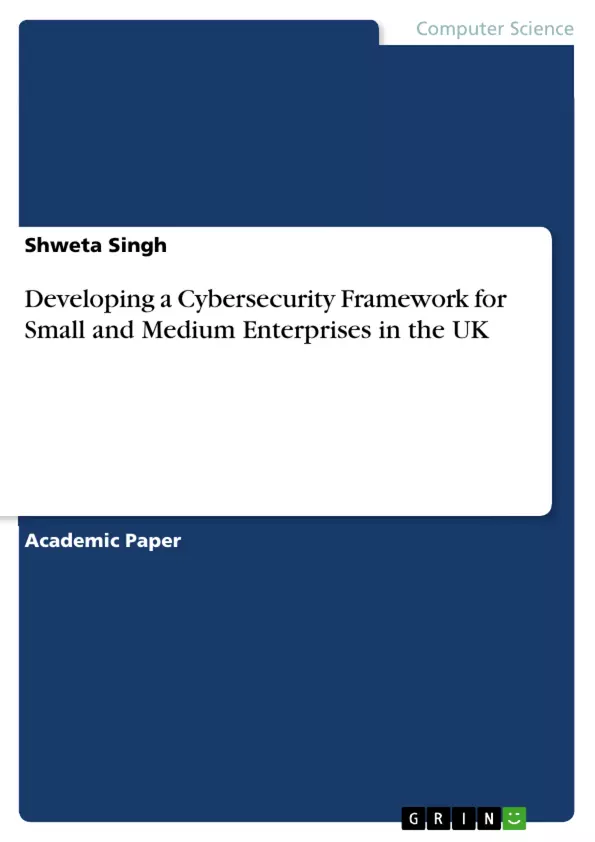This research fills the existing gap of having a general framework for cybersecurity and comes up with strategies best suited for SMEs in the UK. Due to the large number of SMEs in the UK, the economy heavily depends on them; however, those organizations have many cybersecurity issues due to the lack of funds, the increased number of strict rules, and new/advanced types of cyber threats. The study’s goal is to develop an implementable cybersecurity model that can adequately counter these factors and build SME immunity against cyber threats.
The first step undertaken in the study is the review of the literature which seeks to establish specific cybersecurity threats that impact SMEs and assess the preparedness of existing architectures in supporting SMEs. According to it, there is a step-wise cybersecurity framework in terms of policies, standards, and guidelines suitable for SMEs based on their operations and regulatory policies. Examples of Manufacturing, Financial Services, and Healthcare industries make the study applicable and offer practical evidence of the framework application.
Specifically, key findings stress that network segmentation and employee training, which are vital yet inexpensive approaches, are indispensable for addressing cyber threats. The general picture leads to the identification of the regulation as the most important area of concern that directly relates to GDPR and industry standards with an emphasis on ongoing monitoring and updates. Concerning the proposed cybersecurity architecture, ranging from perimeter to data protection layers, it provides a conceptual framework for protecting SMEs’ IT resources.
Possible future research directions include the utilization of new technologies like AI and machine learning for improved threat detection, the improvement of cybersecurity knowledge among the different levels of society, and the involvement of SMEs, cybersecurity specialists, and regulatory entities.
Inhaltsverzeichnis (Table of Contents)
- Abstract
- Chapter 1: Introduction
- 1.1 Introduction
- 1.2 Research Background (problem or improvement area)
- 1.3 Motivation
- 1.4 Aims and Objectives
- 1.5 Research Rationale
- 1.6 Research Questions
- 1.7 Dissertation Structure
- Chapter 2 Literature review
- 2.1 Introduction
- 2.2 Existing Cybersecurity Frameworks
- 2.3 Critical Analysis of SME Cybersecurity Needs in the UK
- 2.4 Specific Cybersecurity Challenges Faced by Small and Medium Enterprises
- 2.5 Adapting Existing Cybersecurity Frameworks to Meet the Unique Needs and Constraints of SMEs
- 2.6 Implementing and Maintaining a Robust Cybersecurity Posture in SMEs
- 2.7 Analysis of problem/improvement
- 2.8 Summary
- Chapter 3 Research methods
- 3.1 Introduction
- 3.2 Research Philosophy
- 3.3 Research Approach
- 3.4 Research Strategy
- 3.5 Research Method
- 3.6 Data Collection Method
- 3.7 Data Analysis Method
- 3.8 Ethical Considerations
- 3.9 Research Limitations
- 3.10 Summary
- Chapter 4
- 4.1 Introduction
- 4.2 Design of artifact
- 4.2.1 Phases of Cybersecurity Architecture
- 4.2.2 The Proposed Secure (Cybersecurity) Architecture
- 4.3 Implementation/testing/validation of the artifact
- 4.3.1 Methodology: Case Studies of SMEs in the UK
- 4.3.2 Implementation Process of the Cybersecurity Framework for SMEs
- 4.3.3 Testing and Validation
- 4.4 Critical Evaluation
- 4.5 Summary
- Chapter 5 Conclusions and Future Work
Zielsetzung und Themenschwerpunkte (Objectives and Key Themes)
This research aims to develop a practical and cost-effective cybersecurity framework specifically tailored for small and medium-sized enterprises (SMEs) in the UK. The framework addresses the unique challenges faced by SMEs, such as limited resources and expertise, while also considering relevant regulations and industry standards.
- Development of a cybersecurity framework for UK SMEs.
- Analysis of existing cybersecurity frameworks and their applicability to SMEs.
- Identification of specific cybersecurity challenges faced by UK SMEs.
- Implementation and testing of the proposed framework through case studies.
- Exploration of future research directions, including the use of emerging technologies.
Zusammenfassung der Kapitel (Chapter Summaries)
Chapter 1: Introduction introduces the research problem, highlighting the vulnerability of UK SMEs to cyber threats despite their crucial role in the economy. It outlines the research aims and objectives, focusing on developing a cost-effective and practical cybersecurity framework.
Chapter 2: Literature Review examines existing cybersecurity frameworks and analyzes the specific challenges faced by SMEs in the UK. It explores how existing frameworks can be adapted to meet the unique needs and constraints of SMEs, focusing on practical implementation and maintenance of a robust cybersecurity posture.
Chapter 3: Research Methods details the research philosophy, approach, strategy, and methods employed in the study. It describes the data collection and analysis techniques, addressing ethical considerations and research limitations.
Chapter 4: This chapter presents the design, implementation, testing, and validation of the proposed cybersecurity framework. Case studies of UK SMEs are used to illustrate the implementation process and the testing methodology. A critical evaluation of the framework is also provided.
Schlüsselwörter (Keywords)
Cybersecurity, SMEs, UK, framework, cost-effective, implementation, case studies, threat detection, regulation, GDPR, industry standards, employee training, network segmentation.
- Quote paper
- Shweta Singh (Author), 2024, Developing a Cybersecurity Framework for Small and Medium Enterprises in the UK, Munich, GRIN Verlag, https://www.grin.com/document/1510215



